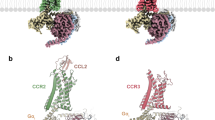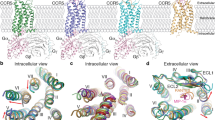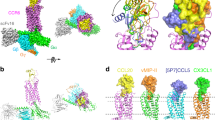Abstract
Chemokines coordinate leukocyte trafficking by promoting oligomerization and signaling by G protein–coupled receptors; however, it is not known which amino acid residues of the receptors participate in this process. Bioinformatic analysis predicted that Ile52 in transmembrane region-1 (TM1) and Val150 in TM4 of the chemokine receptor CCR5 are key residues in the interaction surface between CCR5 molecules. Mutation of these residues generated nonfunctional receptors that could not dimerize or trigger signaling. In vitro and in vivo studies in human cell lines and primary T cells showed that synthetic peptides containing these residues blocked responses induced by the CCR5 ligand CCL5. Fluorescence resonance energy transfer showed the presence of preformed, ligand-stabilized chemokine receptor oligomers. This is the first description of the residues involved in chemokine receptor dimerization, and indicates a potential target for the modification of chemokine responses.
This is a preview of subscription content, access via your institution
Access options
Subscribe to this journal
Receive 12 print issues and online access
$209.00 per year
only $17.42 per issue
Buy this article
- Purchase on Springer Link
- Instant access to full article PDF
Prices may be subject to local taxes which are calculated during checkout





Similar content being viewed by others
References
Mackay, C.R. Chemokines: immunology's high impact factors. Nat. Immunol. 2, 95–101 (2001).
Rossi, D. & Zlotnik, A. The biology of chemokines and their receptors. Annu. Rev. Immunol. 18, 217–242 (2000).
Mellado, M., Rodríguez-Frade, J.M., Mañes, S. & Martínez-A., C. Chemokine signaling and functional responses: the role of receptor dimerization and TK pathway activation. Ann. Rev. Immunol. 19, 397–421 (2001).
Angers, S., Salahpour, A. & Bouvier, M. Dimerization: an emerging concept for G protein-coupled receptor ontogeny and function. Annu. Rev. Pharmacol. Toxicol. 42, 409–435 (2002).
Hebert, T.E. et al. A peptide derived from a β2-adrenergic receptor transmembrane inhibits both receptor dimerization and activation. J. Biol. Chem. 271, 16384–16392 (1996).
Zeng, F.Y. & Wess, J. Identification and molecular characterization of m3 muscarinic receptor dimers. J. Biol. Chem. 274, 19487–19497 (1999).
Kaupmann, K et al. GABAB-receptor subtypes assemble into functional heteromeric complexes. Nature 396, 683–687 (1998).
Galvez, T. et al. Allosteric interactions between GB1 and GB2 subunits are required for optimal GABA(B) receptor function. EMBO J. 20, 2152–2159 (2001).
Milligan, G. Oligomerization of G-protein-coupled receptors. J. Cell Sci. 114, 1265–1271 (2002).
Tsuji, Y. et al. Cryptic dimer interface and domain organization of the extracellular region of metabotropic glutamate receptor subtype 1. J. Biol. Chem. 275, 28144–28151 (2000).
White, J.H. et al. Heterodimerization is required for the formation of a functional GABAB receptor. Nature 396, 679–682 (1998).
Filizola, M. & Weinstein, H. Structural models for dimerization of G-protein coupled receptors: the opioid receptor homodimers. Biopolymers 66, 317–325 (2002).
Benkirane, M., Jin, D.Y., Chun, R.F., Koup, R.A. & Jeang, K.T. Mechanism of transdominant inhibition of CCR5-mediated HIV-1 infection by ccr5Δ32. J. Biol. Chem. 272, 30603–30606 (1997).
Issafras, H. et al. Constitutive agonist-independent CCR5 oligomerization and antibody-mediated clustering occurring at physiological levels of receptors. J. Biol. Chem. 277, 34666–34673 (2002).
Babcock, G.J., Farzan, M. & Sodroski, J. Ligand-independent dimerization of CXCR4, a principal HIV-1 coreceptor. J. Biol. Chem. 278, 3378–3385 (2003).
Blanpain, C. et al. Multiple active states and oligomerization of CCR5 revealed by functional properties of monoclonal antibodies. Mol. Biol. Cell 13, 723–737 (2002).
Rodríguez-Frade, J.M., Mellado, M. & Martínez-A., C. Chemokine receptor dimerization: two are better than one. Trends Immunol. 22, 612–617 (2001).
Mellado, M. et al. Chemokine receptor homo- or hetero-dimerization activates distinct signaling pathways. EMBO J. 20, 2497–2507 (2001).
Vila-Coro, A.J. et al. HIV-1 infection through the CCR5 receptor is blocked by receptor dimerization. Proc. Natl. Acad. Sci. USA 97, 3388–3393 (2000).
Gobel, U., Sander, C., Schneider, R. & Valencia, A. Correlated mutations and residue contacts in proteins. Proteins 18, 309–317 (1994).
Pazos, F. & Valencia, A. In silico two-hybrid system for the selection of physically interacting protein pairs. Proteins 47, 219–227 (2002).
Casari, G., Sander, C. & Valencia, A. A method to predict functional residues in proteins. Nat. Struct. Biol. 2, 171–178 (1995).
del Sol Mesa, A., Pazos, F. & Valencia, A. Automatic methods for predicting functionally important residues. J. Mol. Biol. 326, 1289–1302 (2003).
Manes, S. et al. Membrane raft microdomains mediate front-rear polarity in migrating cells. EMBO J. 18, 6211–6220 (1999).
Harder, T., Scheiffele, P., Verkade, P. & Simons, K. Lipid domain structure of the plasma membrane revealed by patching of membrane components. J. Cell Biol. 141: 929–942 (1998).
Kenworthy, A.K. Imaging protein-protein interactions using fluorescence resonance energy transfer microscopy. Methods 24, 289–296 (2001).
Gordon, G.W., Berry, G., Liang, X.H., Levine, B. & Herman, B. Quantitative fluorescence resonance energy transfer measurements using fluorescence microscopy. Biophys. J. 74, 2702–2713 (1998).
Bastiaens, P.I. & Squire, A. Fluorescence lifetime imaging microscopy: spatial resolution of biochemical processes in the cell. Trends Cell Biol. 9, 48–52 (1999).
Angers, S. et al. Detection of β2-adrenergic receptor dimerization in living cells using bioluminescence resonance energy transfer (BRET) Proc. Natl. Acad. Sci. USA 97, 3684–3689 (2000).
Desai, D.M., Newton, M.E., Kadlecek, T. & Weiss A. Stimulation of the phosphatidylinositol pathway can induce T-cell activation. Nature 348,66–69 (1990).
Klemm, J.D., Schreiber, S.L. & Crabtree, G.R. Dimerization as a regulatory mechanism in signal transduction. Annu. Rev. Immunol. 16, 569–592 (1998).
Devi, L. Heterodimerization of G-protein-coupled receptors: pharmacology, signaling and trafficking. Trends Pharm. Sci. 22, 532–537 (2001).
Gether, U. Uncovering molecular mechanisms involved in activation of G protein-coupled receptors. Endocrinol. Rev. 21, 90–113 (2000).
Ghanouni, P., Steenhuis, J.J., Farrens, D.L. & Kobilka, B.K. Agonist-induced conformational changes in the G protein-coupling domain of the β2 adrenergic receptor. Proc. Natl. Acad. Sci. USA 98, 5997–6002 (2001).
Ri, Y. et al. The role of a conserved proline residue in mediating conformational changes associated with voltage gating of Cx32 gap junctions. Biophys J. 76, 2887–2889 (1999).
Govaerts, C. et al. The TXP motif in the second transmembrane helix of CCR5. J. Biol. Chem. 276, 13217–13225 (2001).
Soriano, S.F. et al. Chemokines integrate JAK/STAT and G protein pathways during chemotaxis and calcium flux responses. Eur. J. Immunol. 33, 1328–1333 (2003).
Onuffer, J.J. & Horuk R. Chemokines, chemokine receptors and small-molecule antagonists: recent developments. Trends Pharm. Sci. 23, 459–467 (2002).
Tarasova, N.I., Rice, W.G. & Michejda, C.J. Inhibition of G-protein-coupled receptor function by disruption transmembrane domain interactions. J. Biol. Chem. 274, 34911–34915 (1999).
Dragic, T. et al. A binding pocket for small molecule inhibitor of HIV-1 entry within the transmembrane helices of CCR5. Proc. Natl. Acad. Sci. USA 97, 5639–5644 (2000).
Mirzadegan, T et al. Identification of the binding site for a novel class of CCR2b chemokine receptor antagonists. J. Biol. Chem. 275, 25562–25571 (2000).
Horn, F. et al. GPCRDB information system for G protein-coupled receptors. Nucleic Acids Res. 31, 294–297 (2003).
Notredame, C., Higgins, D.G. & Heringa, J. T-Coffee: a novel method for fast and accurate multiple sequence alignment. J. Mol. Biol. 302, 205–217 (2000).
Filizola, M., Olmea, O. & Weinstein, H. Prediction of heterodimerization interfaces of G-protein coupled receptors with a new subtractive correlated mutation method. Protein Eng. 15, 881–885 (2002).
Palczewski, K. et al. Crystal structure of rhodopsin: a G protein–coupled receptor. Science 289, 739–745 (2000).
Katchalski-Katzir, E. et al. Molecular surface recognition: determination of geometric fit between proteins and their ligands by correlation techniques. Proc. Natl. Acad. Sci. USA 89, 2195–2199 (1992).
Vakser, I.A. & Jiang, S. Strategies for modeling the interactions of transmembrane helices of G protein-coupled receptors by geometric complementarity using the GRAMM computer algorithm. Methods Enzymol. 343, 313–328 (2002).
Pazos, F., Helmer-Citterich, M., Ausiello, G. & Valencia, A. Correlated mutations contain information about protein-protein interaction. J. Mol. Biol. 271, 511–523 (1997).
Gong, X. et al. Monocyte chemotactic protein-2 (MCP-2) uses CCR1 and CCR2B as its functional receptors. J. Biol. Chem. 272, 11682–11685 (1997).
Mellado, M. et al. The chemokine MCP-1 triggers tyrosine phosphorylation of the CCR2B receptor and the JAK2/STAT3 pathway. J. Immunol. 161, 805–813 (1998).
Gausepohl, H. et al. Automated multiple peptide synthesis. Peptide Res. 5, 315–320 (1992).
Sorkin, A., McClure, M., Huang, F. & Carter, R. Interaction of EGF receptor and grb2 in living cells visualized by fluorescence visualized by fluorescence resonance energy transfer (FRET) microscopy. Curr. Biol. 10, 1395–1398 (2000).
Gu, C., Cali, J.J. & Cooper, D.M. Dimerization of mammalian adenylate cyclases. Eur. J. Biochem. 269, 413–421 (2002).
Xia, Z. & Liu, Y. Reliable and global measurement of fluorescence resonance energy transfer using fluorescence resonance energy transfer (FRET) microscopy. Biophys. J. 81, 2395–4028 (2001).
Acknowledgements
We thank J.P. Albar for peptide synthesis, J. Gutiérrez for chemokine receptor transfectants, M.C. Moreno-Ortíz for help with FACS analysis, and C. Bastos and C. Mark for secretarial and editorial assistance, respectively. Partially supported by grants from the Spanish Comisión Interministerial de Ciencia y Technología and from the Ministry of Health. The Department of Immunology and Oncology was founded and is supported by the Spanish Council for Scientific Research (CSIC) and by Pfizer.
Author information
Authors and Affiliations
Corresponding author
Ethics declarations
Competing interests
The authors declare no competing financial interests.
Rights and permissions
About this article
Cite this article
Hernanz-Falcón, P., Rodríguez-Frade, J., Serrano, A. et al. Identification of amino acid residues crucial for chemokine receptor dimerization. Nat Immunol 5, 216–223 (2004). https://doi.org/10.1038/ni1027
Received:
Accepted:
Published:
Issue Date:
DOI: https://doi.org/10.1038/ni1027
This article is cited by
-
Structural basis of dimerization of chemokine receptors CCR5 and CXCR4
Nature Communications (2023)
-
The marriage of chemokines and galectins as functional heterodimers
Cellular and Molecular Life Sciences (2021)
-
Regulation of CCR7-dependent cell migration through CCR7 homodimer formation
Scientific Reports (2017)
-
Improving the catalytic activity of isopentenyl phosphate kinase through protein coevolution analysis
Scientific Reports (2016)
-
Emerging methods in protein co-evolution
Nature Reviews Genetics (2013)



